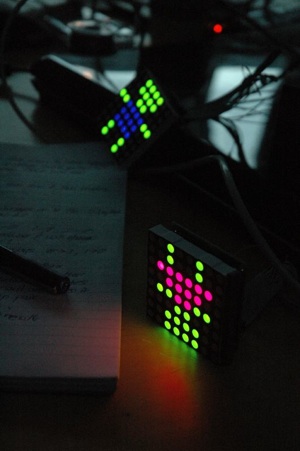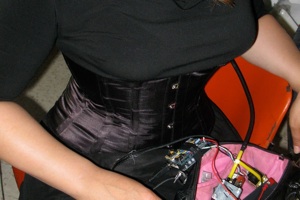A magazine where the digital world meets the real world.
On the web
- Home
- Browse by date
- Browse by topic
- Enter the maze
- Follow our blog
- Follow us on Twitter
- Resources for teachers
- Subscribe
In print
What is cs4fn?
- About us
- Contact us
- Partners
- Privacy and cookies
- Copyright and contributions
- Links to other fun sites
- Complete our questionnaire, give us feedback
Search:
How to win love by not playing cool

You know that feeling of awkwardness when you’re talking to someone you fancy? That special mix of exhilaration and horror as you sweat, smile and stammer your way through an encounter with your beloved? It might be tempting to think that if you could just be cool and not give anything away, you’d be on your way to snagging the girl or boy of your dreams. Actually, as Vanessa Carpenter has found out, maybe what we need is more potential embarrassment, not less.
Vanessa works as an artist and designer for a group called Illutron and GeekPhysical in Copenhagen, Denmark. The projects she’s done with her colleagues Mads Høbye and Dzl Møbius all use computers as a way to get people to socialise. One of the best ways to break the ice is to give people a chance to open up with one another. To share a moment that’s a little bit personal. Maybe even a little bit…embarrassing. Take a look at a few of Vanessa’s projects and find out what awkwardness could do for your pulling power. Before you do, though, we should explain that when we say Vanessa works with computers, we’re not talking about computers like the ones that sit on desks. She works in 'physical computing', building interactive gadgets that work within the real world. Designers in physical computing make computerised electronic gadgets with things like sensors, motors and displays. Here you’ll see Vanessa’s icebreaking designs at work in a toilet door, a corset and projected onto walls.
The ladies’ and men’s room mixup

It started with nightclubs. To get ideas, Vanessa’s group went to observe people in clubs and watched them struggle with a big problem. "They’re with their friends and it’s supposed to be this social place to meet someone, but it’s almost impossible to approach someone," she explains. "It’s really hard to do the pickup or even make new friends in a nightclub because everyone’s suspicious." You have to talk to someone to get to know them, but there’s never a good excuse – leading to billions of bad chat-up lines. In awkward situations, though, talking is essential to fix things. So how do you create an awkward situation in a nightclub?
What Vanessa’s group did was to replace the usual signs on the toilet doors with electronic displays whose symbols could change. Sometimes guys would head for what they thought was the right loo, only to see a group of girls come out. Groups of people outside and inside the toilets talked to one another to try and figure out what was going on. Sometimes the people who had figured out the game would try and guide other groups to the right place, or cheekily enter the 'wrong' toilet on purpose. As long as there were some people who didn’t know what was happening, the awkward situation produced lots of playful interaction between the girls and guys in the club.
Your heart, but not on your sleeve
Pretend you’re on a date. Your heart’s pounding, you might be getting clammy hands, but you hope your date will never know. "So how do we get past that," Vanessa asks, "stop playing cool and start being honest here?" What she designed was a corset that tells the person wearing it when her heart rate rises, by getting tighter. Vanessa got a corset and put a heart rate monitor for runners inside it. Then she attached it to a circuit board that monitored the signal it got from the heart. When the wearer’s heartbeat went above 75 beats a minute, the computer pumped air into pockets around the corset, which kept it tight until her heart rate went down again. That did two things: it told the wearer 'hey, your body thinks you’re doing something interesting' and it gave them a sort of hugging feeling from the tightened corset.
Vanessa tested it by wearing it to a party, where, she says, "what ended up happening was kind of beautiful". Because of the music and talking in the party no one could hear the pump working, so Vanessa could be the only one who knew when her heart rate was up. Except when she and a friend left to get some supplies, the friend could hear the corset filling up as well. "So then he was aware every time my heart rate went up," says Vanessa, laughing. "So that was really embarrassing, because it was every five minutes and it was like, 'oh dear'." But once again, the situation was saved by awkwardness. Embarrassment turned into flirting, and pretty soon Vanessa and her friend were a couple.

Projecting your feelings
Sure, the corset worked when Vanessa was excited about being around someone, but it also inflated when she drank a Red Bull and went on the dance floor. So Vanessa and Illutron began working on a better system that works on more than just heart rate. Now they have one that looks at heart rate, body temperature, and even changes in your skin’s electrical response. All those signals get sent to a laptop, and if you’re at one of Vanessa’s events, projected onto the wall.
You might think it would be embarrassing to have your body chemistry projected up onto a wall for everyone to see, but it turns out the effect can be exactly the opposite. At one party, Vanessa says, there were three shy guys sitting together, hiding from the crowd. She asked them if they’d mind putting on the monitors. They weren’t sure at first but they agreed. Immediately, Vanessa says, their heart rates went through the roof, but after a few minutes they settled down…and suddenly they got confidence. "Then," says Vanessa, "three guys who were hiding in a corner are now going up to all the prettiest girls in the room and saying 'hey, that’s my heart rate on the wall. Isn’t that cool?' so now they have an excuse to talk to people." Once again, Vanessa and her group manage to fight awkwardness with awkwardness.


